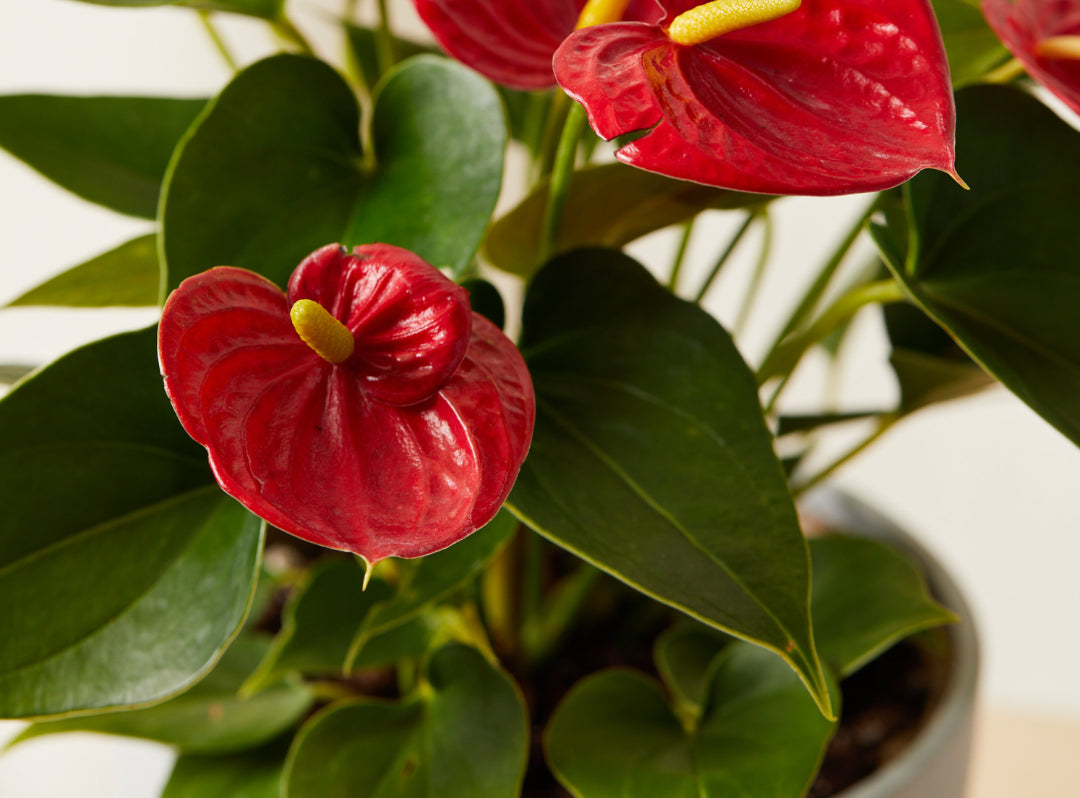- ☀️ Light
Thrives in bright indirect light. Avoid direct sunlight.
- 💧 Watering
Water every 1 to 2 weeks, allowing the soil to dry out between waterings. Expect to water more often in brighter light and less often in lower light.
- 🤒 Signs of a sad plant
Yellowing leaves: too much direct sunlight
New flowers are green rather than red or pink: too much sun
Flowers turn pale green: underwatering or bad temperature
- ❤️🩹 Easy to keep them alive
❤️🩹❤️🩹❤️🩹❤️🩹 /5
All about Anthurium
This trendy plant is known and recognized for its exotic beauty, its heart-shaped leaves and its vibrantly colored flowers. Anthurium is an ideal choice for those who love touches of color and especially very cute plants.
History and origin of Anthurium
Anthurium belongs to a genus comprising about 950 species distributed throughout Central and South America. It is estimated that there could be as many as 2000 species, most of which have not yet been discovered 🤯
Among the most commonly grown species are Anthurium andreanum and Anthurium scherzerianum, known for their beautiful inflorescences and ease of cultivation. These plants are not only valued for their unique appearance but also for their resilience and ability to adapt to various environments.
Growing conditions
Anthuriums thrive in bright but indirect light. In the wild, they grow under the canopy of rainforests, benefiting from subdued light. So place them indoors near a window and position it in a way that the light is diffused and not too direct.
These plants like warmth and humidity.
Maintain a temperature between 21°C and 32°C and avoid cold drafts . Also make sure not to place your Anthurium near sources of cold such as open windows in winter or air conditioners in summer, as this could stress the plant.
Watering and fertilization
Anthuriums should be watered regularly, but the soil should drain well to avoid standing water. Use a light, airy potting mix, ideally with perlite and bark. This will allow water to circulate freely and prevent the roots from rotting.
During the growing season (March to October), you can use our Green Plant Nourishing Serum . This formula will promote flower production and keep the plant healthy.
To use it, nothing could be simpler!
Add 3 drops to 250 ml of irrigation water.
You can use it every other watering during the growing period.
Maintenance and size
Wipe the leaves with a damp cloth to remove dust and improve photosynthesis. This allows the plant to breathe and absorb light better. Prune off dead leaves and flowers to encourage new flower growth.
You can also divide the plant to take cuttings. Cutting off damaged or dead parts will encourage the plant to produce new shoots and remain vigorous.
Cuttings
Carefully remove the plant from its pot, separate the clumps by untangling the roots, and replant each section in a new pot with the appropriate soil mix.
This method is simple and effective to multiply your plants without the need for complex growing techniques. Make sure each new plant has enough space to grow and continue to water and fertilize them regularly.
Common Problems and Solutions
Yellowing leaves can be caused by overwatering or underwatering. Make sure the soil is moist but well-drained. Brown spots can indicate direct sunlight. Move the plant to a location with indirect light.
If your plant is not flowering, check the light and try to stimulate it with a natural fertilizer.


